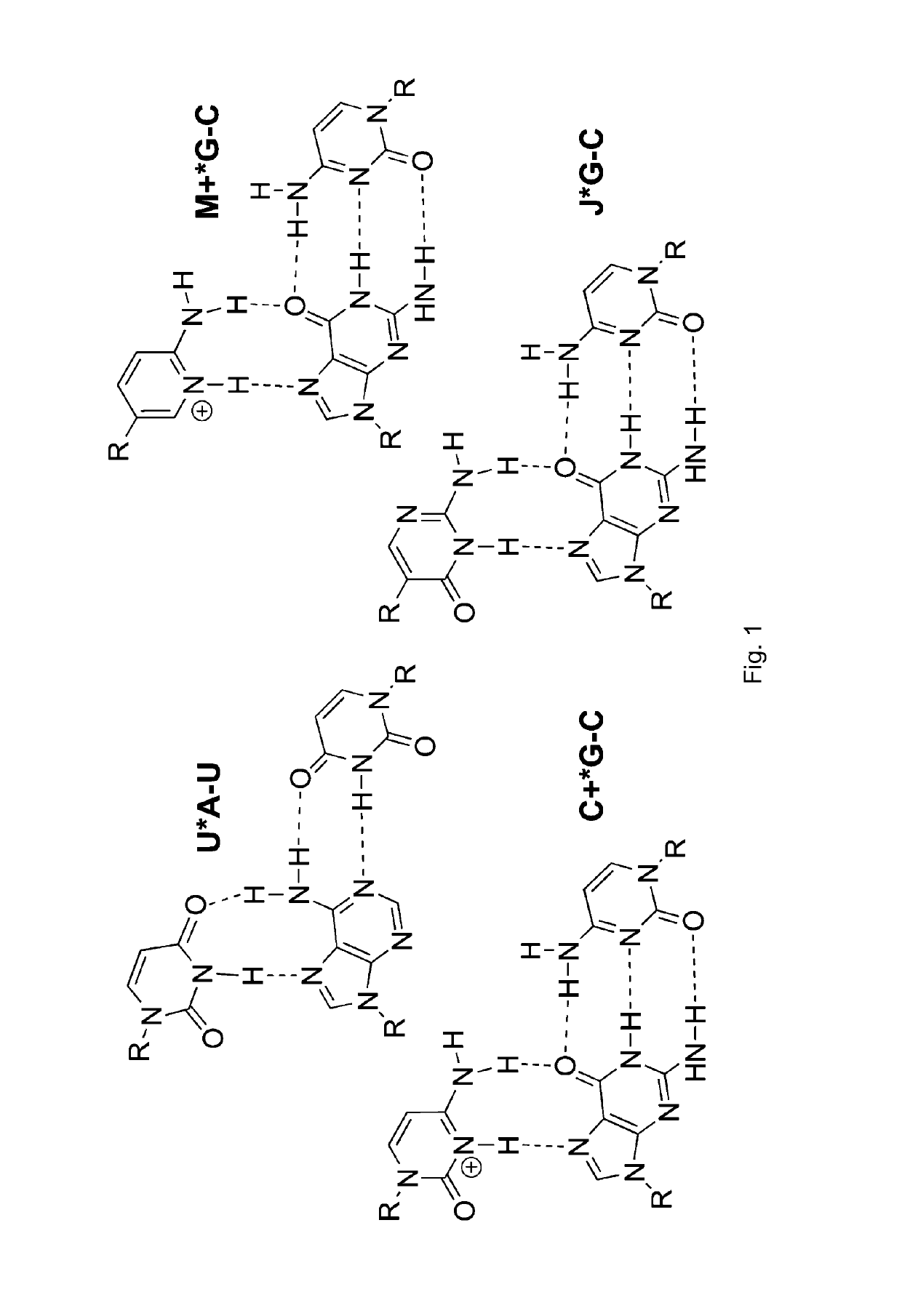Compositions and methods for recognition of RNA using triple helical peptide nucleic acids
a technology of rna and nucleic acids, which is applied in the direction of peptides, biochemical instruments and processes, microbiological testing/measurement, etc., can solve the problems of limited in vivo applications of unmodified pna, and achieve excellent chemical and biophysical properties, enhanced cellular delivery, and strong and sequence-specific binding
- Summary
- Abstract
- Description
- Claims
- Application Information
AI Technical Summary
Benefits of technology
Problems solved by technology
Method used
Image
Examples
example 1
[0035]The binding of unmodified PNA1, J modified PNA2 and M-modified PNA3 were compared to HRPA (FIG. 2), an A-rich RNA hairpin similar to the model systems used previously.[4, 5] See [29]. Fmoc-protected J monomer 1 was synthesized according to the literature procedure.[21] The M monomer 2 was synthesized from Fmoc-protected PNA backbone 3 and the known carboxylic acid 4 using DCC mediated coupling followed by deprotection of the allyl group as previously described (Scheme 1).[5] All PNAs were synthesized using a standard PNA protocol on an Expedite 8909 DNA synthesizer, purified by HPLC and characterized by mass spectroscopy as previously reported.[4-6, 29]
[0036]
[0037]Synthesis of M PNA Monomer:
[0038]a) DCC, 3-hydroxy-1,2,3-benzotriazin-4(3H)-one, DMF, RT, overnight, 57%;
[0039]b) [Pd(PPh3) 4], N ethylaniline, THF, RT, 2 h, 79%.
[0040]Following the same approach as in our previous studies,[4-6] isothermal titration calorimetry (ITC) and UV thermal melting were used to characterize t...
example 2
[0076]Conjugation of short peptide nucleic acids (PNA) with tetralysine peptides strongly enhanced triple helical binding to RNA at physiologically relevant conditions.[98] The PNA hexamers and heptamers carrying cationic nucleobase and tetralysine modifications displayed high binding affinity for complementary double-stranded RNA without compromising sequence selectivity. The PNA-peptide conjugates had unique preference for binding double-stranded RNA, while having little, if any, affinity for double-stranded DNA, as represented in FIG. 5. The cationic PNAs were efficiently taken up by HEK293 cells, whereas little uptake was observed for unmodified PNA.
[0077]Peptide nucleic acids (PNA) have become important research tools for molecular recognition of double helical DNA.[30] Although PNA-DNA triple helices have been studied in detail,[31] analogous PNA-RNA triplexes were virtually unknown prior to [4-5, 29]. PNA was discovered to form stable and sequence-selective Hoogsteen triple h...
example 3
Experimental Procedures
[0122]Isothermal titration calorimetry and fluorescence spectroscopy were used to study binding of GPNA, which is distinct from PNA studied in Examples 1 and 2, to double-helical RNA.[6] The results were further confirmed using circular dichroism (CD) spectroscopy and a gel mobility shift assay. Guanidine modification was found to reduce the affinity and sequence selectivity of PNA with respect to complementary double-helical RNA. The binding stoichiometry increased to a 2:1 PNA-RNA complex, suggesting that the most likely mode of binding was a strand invasion triplex. While GPNA did not favor triple-helix formation, strong and sequence selective recognition of transactivation response element (TAR) RNA of HIV-1 was achieved using the GPNA derived from D-arginine in a strand invasion mode. Unmodified and nucleobase-modified PNA also gave promising results for triple-helical recognition of bacterial A-site RNA.
[0123]Isothermal Titration calorimetry. In a typica...
PUM
 Login to View More
Login to View More Abstract
Description
Claims
Application Information
 Login to View More
Login to View More - R&D
- Intellectual Property
- Life Sciences
- Materials
- Tech Scout
- Unparalleled Data Quality
- Higher Quality Content
- 60% Fewer Hallucinations
Browse by: Latest US Patents, China's latest patents, Technical Efficacy Thesaurus, Application Domain, Technology Topic, Popular Technical Reports.
© 2025 PatSnap. All rights reserved.Legal|Privacy policy|Modern Slavery Act Transparency Statement|Sitemap|About US| Contact US: help@patsnap.com



